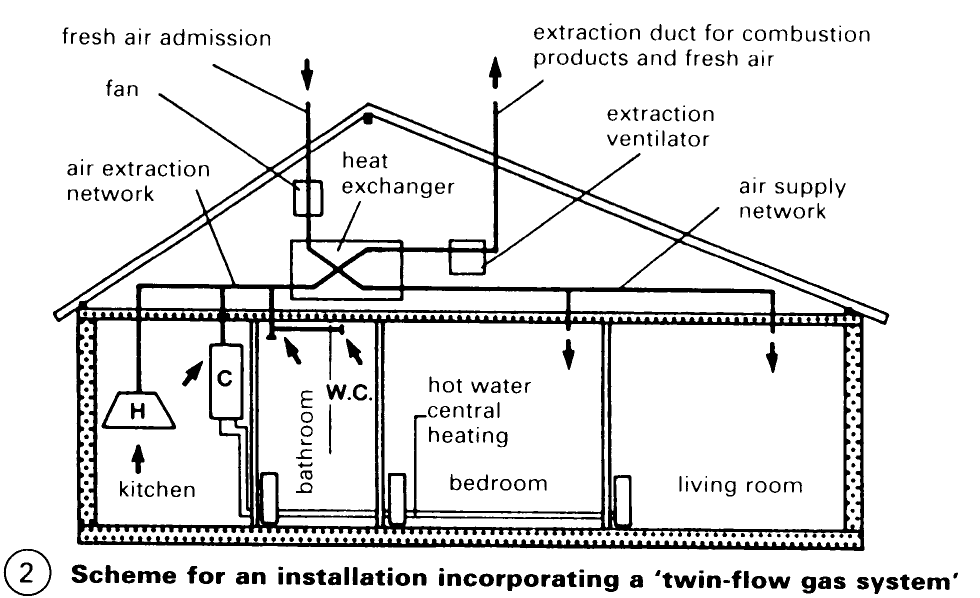Ventilation and Air Condition. Natural Ventilation. Filtering
Air movement is caused by pressure differences, i.e., disturbances to the state of equilibrium, resulting from:
1. temperature differences
2. natural wind
3. ventilators

Room ventilation systems are used to guarantee a specific room climate. In fulfilling this objective, the following requirements must be satisfied, depending on the application:
a) Removal from rooms of impurities in the air including smoke and other harmful substances, and suspended particles
b) Removal of perceptible heat from rooms: unwanted quantities of both hot and cold air
c) Removal of latent heat from rooms: enthalpy flows of humidifying air and dehumidifying air
d) Protective pressure maintenance: pressure maintenance in buildings for protection against unwanted air exchange.
Most of the requirements under (a) are solved through continuous replacement of air (ventilation) and/or suitable air treatment (filtering). Requirements of type (b) and (c) are usually met by appropriate thermodynamic treatment of the air, and, to a limited degree, by air replacement. Requirements of type (d) are solved by various types of mechanical control of supply and extraction air.
Natural ventilation. Uncontrolled air is admitted through joints and gaps in window frames, doors and shutters (as a result of the effects of wind) rather than through the walls. However, the increased use of thermal insulation measures in buildings means that the natural sources of ventilation through gaps in windows and doors may no longer be adequate. It may therefore be necessary to provide controlled ventilation in living accommodation, using mechanical ventilation systems and, if necessary, to replace the heat lost as a consequence.
Window ventilation – (5) - (8) p.179 is generally adequate for living rooms. Sash windows are favourable, where the outside air is admitted at the bottom and internal air flows out above.


Intensive ventilation is brought about by mechanical ventilation systems. In accordance with the building regulations, this is a requirement for windowless bathrooms and WCs, with the removal of air to the outside via ducting. Allowance should be made for the requirement of a flow of replenishment air through ventilator grills, windows and/or gaps in the fabric of the building. Furthermore, as far as is possible, draught-free admission of the outside air must be provided.
The installation of simple ventilator grills in outside walls for inflow and outflow of air leads to the danger of draughts in the winter. Mechanical ventilation systems are better.

Humidity of room air. For comfort, the upper limit for the moisture content of the air is 11.5kg of water per kg of dry air. A relative humidity of 65% should not be exceeded. The minimum flow of fresh air per person for cinemas, banqueting halls, reading rooms, exhibition halls, sale rooms, museums and sports halls is 20m3/h. The value for individual offices, canteens, conference rooms, rest rooms, lecture halls and hotel rooms is 30m3/h; it is 40m3/h for restaurants, and 50m3/h for open plan offices.
Several handling stages are usually involved in ventilation and air conditioning. Filtering; air heating; air cooling; and washing, humidifying and evaporative cooling are discussed on this page. For ventilation and damping.
Filtering. Air cleaning to eliminate coarse dust particles:
(a) Oiled metal filter plates in air filter chambers or automatic circulation filters; used particularly for the ventilation of industrial premises. Disadvantage: entrainment of oil mist.
(b) Dry layer filter mats made of textile or glass fibre in metal frames; not recoverable; also as roll tape filter with automatic cleaning.

Fine cleaning and separation of fine soot
(c) Electrostatic air filter; the dust is ionised and deposited on negatively charged metal plates. Very low air resistance. Disadvantages: large filter chambers; cleaning with warm water.
(d) Fine filtering through filter media of paper, or glass fibre. Advantages: cheap to manufacture; no corrosion from air containing harmful substances; high operating safety. Disadvantage: greater air resistance than electro filters, which increases as the filter is soiled, leading to disruption of the air flow.
(e) Air washing: removes dust or aerosols and acid fumes, but not soot, and therefore should not be used in areas with many oil-fired heating installations.
Air heating
(a) Controllability is limited with simple gravity-circulation solid-fuel heating installations.
(b) Controllability is good with natural gas and heating oil, and with electrically heated equipment.
(c) Heating with low-pressure steam, warm and hot water, using finned tube radiators made from galvanised steel or copper tube with copper or aluminium fins. Good, simple controllability. No need for local chimneys and flues.
Date added: 2023-01-05; views: 546;
